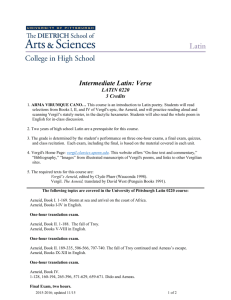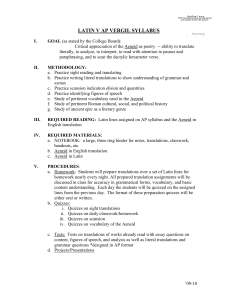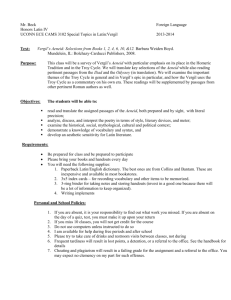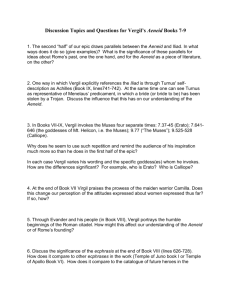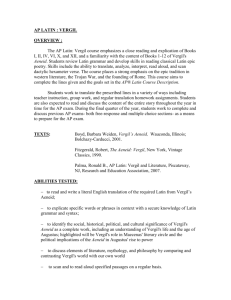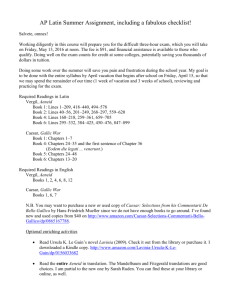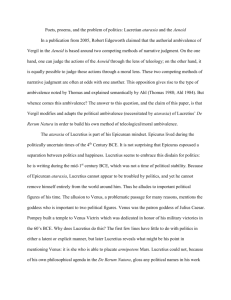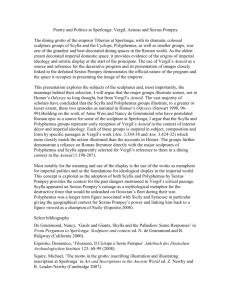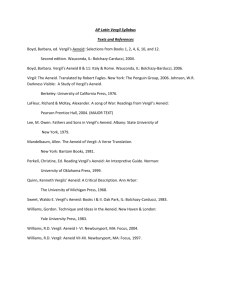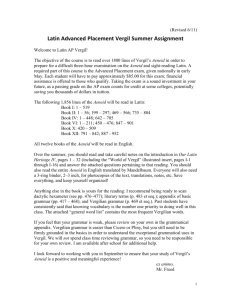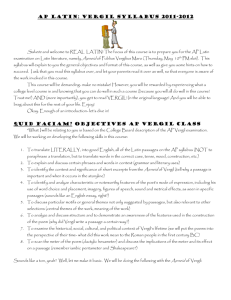AP Latin-Vergil - Syllabus
advertisement
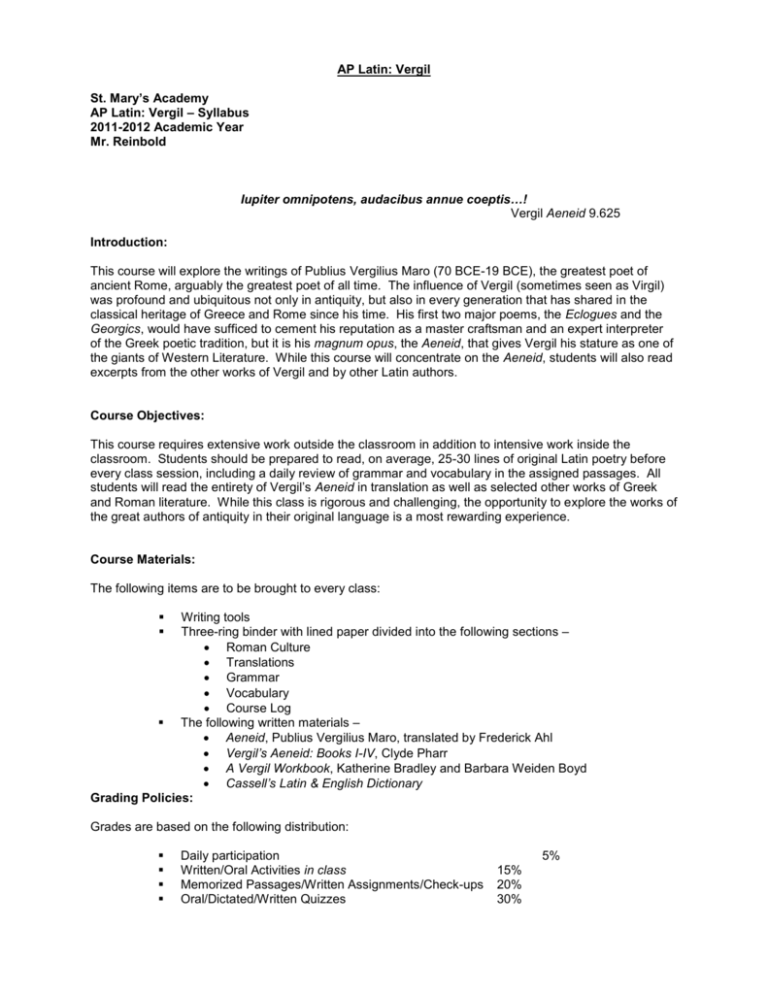
AP Latin: Vergil St. Mary’s Academy AP Latin: Vergil – Syllabus 2011-2012 Academic Year Mr. Reinbold Iupiter omnipotens, audacibus annue coeptis…! Vergil Aeneid 9.625 Introduction: This course will explore the writings of Publius Vergilius Maro (70 BCE-19 BCE), the greatest poet of ancient Rome, arguably the greatest poet of all time. The influence of Vergil (sometimes seen as Virgil) was profound and ubiquitous not only in antiquity, but also in every generation that has shared in the classical heritage of Greece and Rome since his time. His first two major poems, the Eclogues and the Georgics, would have sufficed to cement his reputation as a master craftsman and an expert interpreter of the Greek poetic tradition, but it is his magnum opus, the Aeneid, that gives Vergil his stature as one of the giants of Western Literature. While this course will concentrate on the Aeneid, students will also read excerpts from the other works of Vergil and by other Latin authors. Course Objectives: This course requires extensive work outside the classroom in addition to intensive work inside the classroom. Students should be prepared to read, on average, 25-30 lines of original Latin poetry before every class session, including a daily review of grammar and vocabulary in the assigned passages. All students will read the entirety of Vergil’s Aeneid in translation as well as selected other works of Greek and Roman literature. While this class is rigorous and challenging, the opportunity to explore the works of the great authors of antiquity in their original language is a most rewarding experience. Course Materials: The following items are to be brought to every class: Writing tools Three-ring binder with lined paper divided into the following sections – Roman Culture Translations Grammar Vocabulary Course Log The following written materials – Aeneid, Publius Vergilius Maro, translated by Frederick Ahl Vergil’s Aeneid: Books I-IV, Clyde Pharr A Vergil Workbook, Katherine Bradley and Barbara Weiden Boyd Cassell’s Latin & English Dictionary Grading Policies: Grades are based on the following distribution: Daily participation Written/Oral Activities in class Memorized Passages/Written Assignments/Check-ups Oral/Dictated/Written Quizzes 5% 15% 20% 30% Comprehensive Exams 30% If a student misses a class due to an excused absence, the student must do the following: Hand in all homework due on the day of the absence before the next class. Make up any missing classwork within two days. Be prepared to take any quiz or test given on the day of the absence during the next class. If a review period is missed before a test, schedule academic support and a time to take the test as soon as possible. Any work missed due an unexcused absence or tardiness receives 0%. Course Procedures: The following procedures will be standard for each class: Students are to arrive at every class on time, having all necessary materials and having prepared the assignment thoroughly. Before each class, all students will have – Read the assigned passages as many times as necessary to be able to translate the reading at sight from the textbook, without the aid of notes or translation Answered the assigned questions from the workbook to be submitted as homework Written down any questions about difficult or confusing passages Every class will begin with a check-up. Check-ups will have two sections: Key vocabulary words from the readings Either translation and scansion questions, critical interpretation short responses, or questions on stylistic and metrical techniques As a class, students will translate some or all of the assigned readings without the aid of notes or translations. Students should be prepared to share any questions about difficult or confusing passages and to contribute answers to questions other students may have. Great emphasis in this course is placed on the ability and practice of literal translation of the lines of the Aeneid. Students will be required on numerous occasions in each quarter of study to demonstrate their ability and willingness to translate given pieces of the text in as open and literal a manner as possible. New grammar, rhetorical or poetic figures, historical or cultural information will be presented by the teacher. Students will be given sample passages to practice identifying and analyzing newly introduced concepts. Passages either from future readings or from other Latin authors will be handed out to be used for practice in sight translation and scansion. Each class will culminate with a reflection on the day’s lesson and will be written into the course log in each student’s binder. Course logs will be graded for thoroughness, clarity, and neatness. Once per grading period, students will recite from memory a passage from the Aeneid of no less than ten lines, in the original Latin and in proper meter. The recitation will count as a formal assessment and will be graded for clarity, enunciation, accuracy of meter, and expression of emotion. There will be three tests per quarter for the first three quarters of the school year. In the fourth quarter there will be two tests prior to the AP Exam. The tests will include the following: Translations of passages reviewed in class Literal translations of new passages Scansion of reviewed passages and new passages Written analysis and interpretation of an individual passage, explicating its relationship to the following: o The historical, political, and social context of the author o The cultural and literary tradition of the passage o o The themes and topics of the author’s body of work The effect of poetic and rhetorical figures on the meaning of the passage Schedule of Readings, Tests, and Assessments: Week Assignment 1 Dactylic Hexameter and Scansion introduction to Aeneid; Book I. 1-11 Quiz 2 Book I. 12-80 Exam 3 Book I. 81-156 Quiz 4 Book I. 157-222 Exam 5 Book I. 223-288 Quiz (Progress Reports) 6 Book I. 289-324 Exam 7 Book I. 325-410 Quiz 8 Book I. 411-493 Exam 9 Book I. 494-519 Book I. 520-756 in English Quiz (End of Quarter) 10 Book II. 1-56; read 57-198 in English; Book II. 199-219 Exam 11 Book II. 220-297 Quiz 12 Read 298-468 in English; Book II. 469-566 Exam 13 14 Read 567-734 in English; Book II. 735-804 Quiz Read Book III in English; Book IV. 1-104 Exam (Progress Reports) WINTER BREAK 15 Book IV. 105-179 Quiz 16 Book IV. 180-237 Exam FINAL EXAMS – END OF SEMESTER 17 Book IV. 238-330 Quiz 18 Book IV. 331-449 Exam 19 Read Book IV. 450-641 in English; Book IV. 642-705 Quiz 20 Read Book V in English; Book VI. 1-76 Exam 21 Book VI. 77-139 Exam (Progress Reports) 22 Book VI. 140-211; Book VI. 212-449 in English Quiz 23 Book VI. 450-476; read Book VI. 477-846 in English; Book VI. 847-901 Exam 24 Read Books VII, VIII, IX in English Quiz 25 Read Book X. 1-419 in English Exam (End of Quarter) 26 Book X. 420-509 Quiz 27 Read Book XI. in English; read Book XII. 1-790 in English Exam 28 Book XII. 791-842; 843-886 in English Quiz 29 Book XII. 887-952 30 Review for AP Exam ADVANCED PLACEMENT EXAM THURSDAY, MAY 10, 2012 Additional Texts and Reference Materials: Boyd, Barbara, ed., Vergil’s Aeneid: Selections from Books 1, 2, 4, 6, 10, and 12. 2nd edition. Wauconda, Ill.: Bolchazy-Carducci, 2004. Mandlebaum, Allen, tr., The Aeneid of Virgil: A Verse Translation. New York: Bantam Books, 1981. Anderson, William S., The Art of the Aeneid. Wauconda, Ill.: Bolchazy-Carducci, 1989. Anderson, William S. and Lorina N. Quartarone., Approaches to Teaching Vergil’s Aeneid. “Approaches to Teaching World Literature” series. New York: The Modern Language Association of America, 2002. Commager, Steele, ed., Vergil: A Collection of Critical Essays. Englewood Cliffs, N.J.: Prentice Hall, 1966. Daitz, Stephen, The Pronunciation and Reading of Classical Latin: A Practical Guide. Guilford, CT: J. Norton, 1984. Frenkel, Emily, Aeneas: Virgil’s Epic Retold for Young Readers. Newburyport, Mass.: Focus, 2003. Harrison, S. J., ed., Oxford Readings in Vergil’s Aeneid. Oxford: Oxford University Press, 1990. Johnson, W. R., Darkness Visible: A Study of Vergil’s Aeneid. Berkeley: University of California Press, 1976. Quinn, Stephanie and Michael C. J. Putnam, eds., Why Vergil? A Collection of Interpretations. Wauconda, IL: Bolchazy–Carducci, 2000. Williams, R. D., Virgil: Aeneid I-VI. Newburyport, Mass.: Focus, 2004. Williams, R. D., Virgil: Aeneid VII-XII. Newburyport, Mass.: Focus, 1997. Quarterly Schedule ~ finis ~
